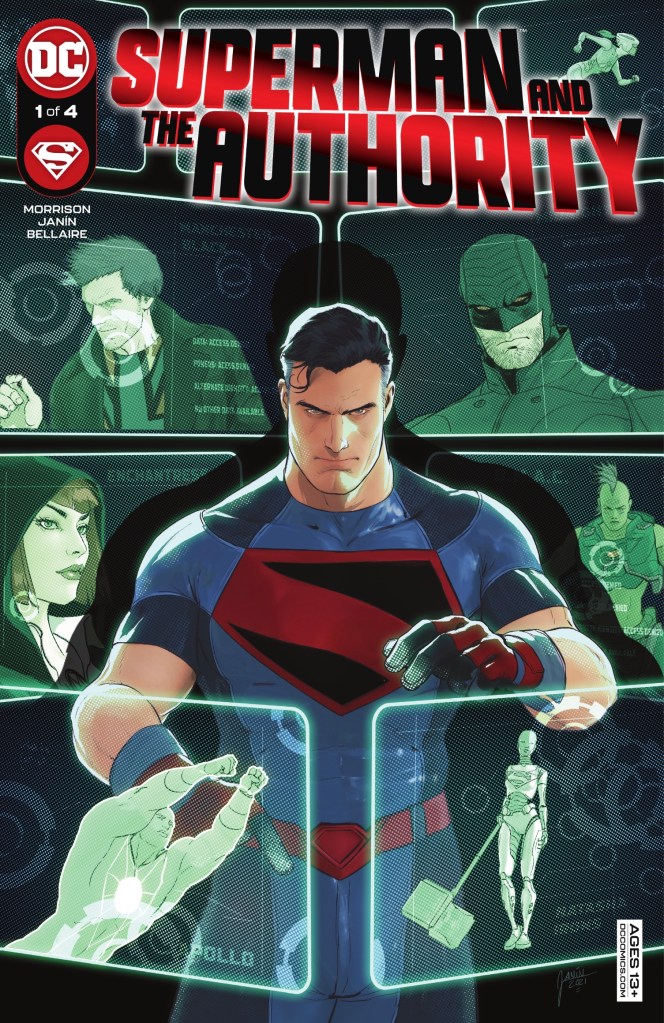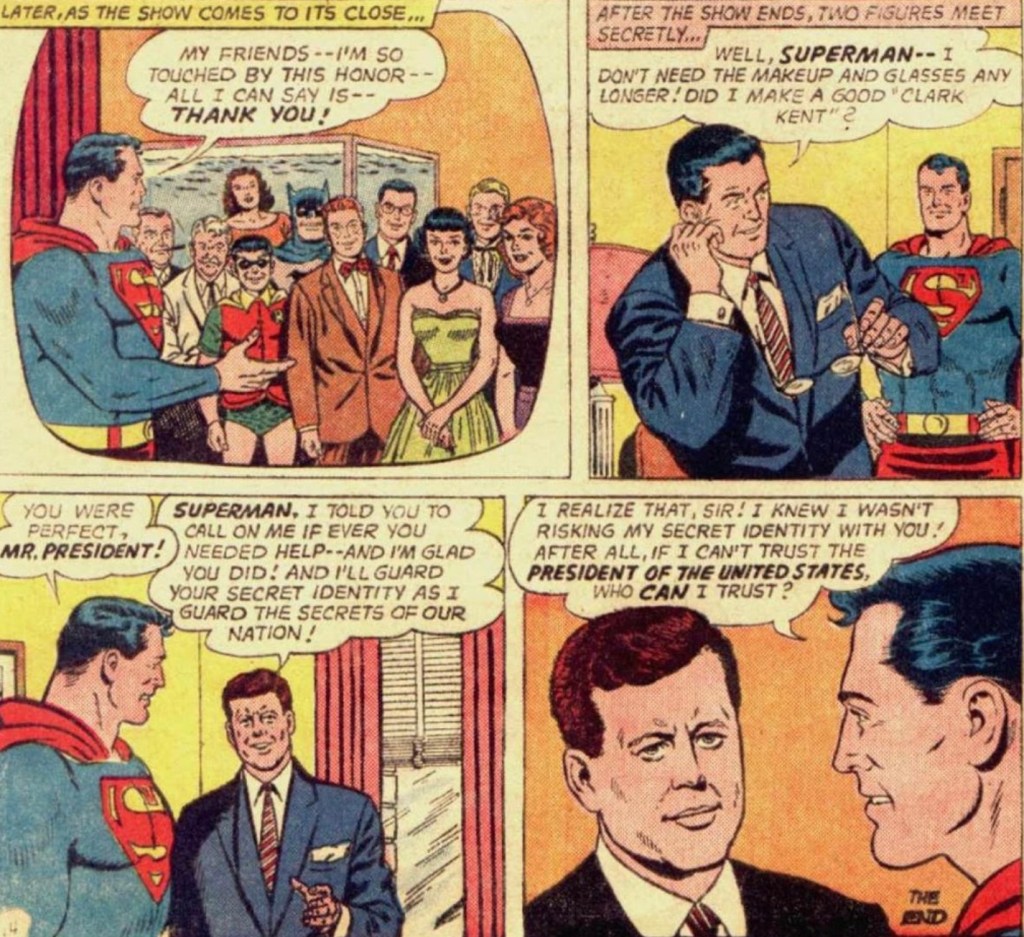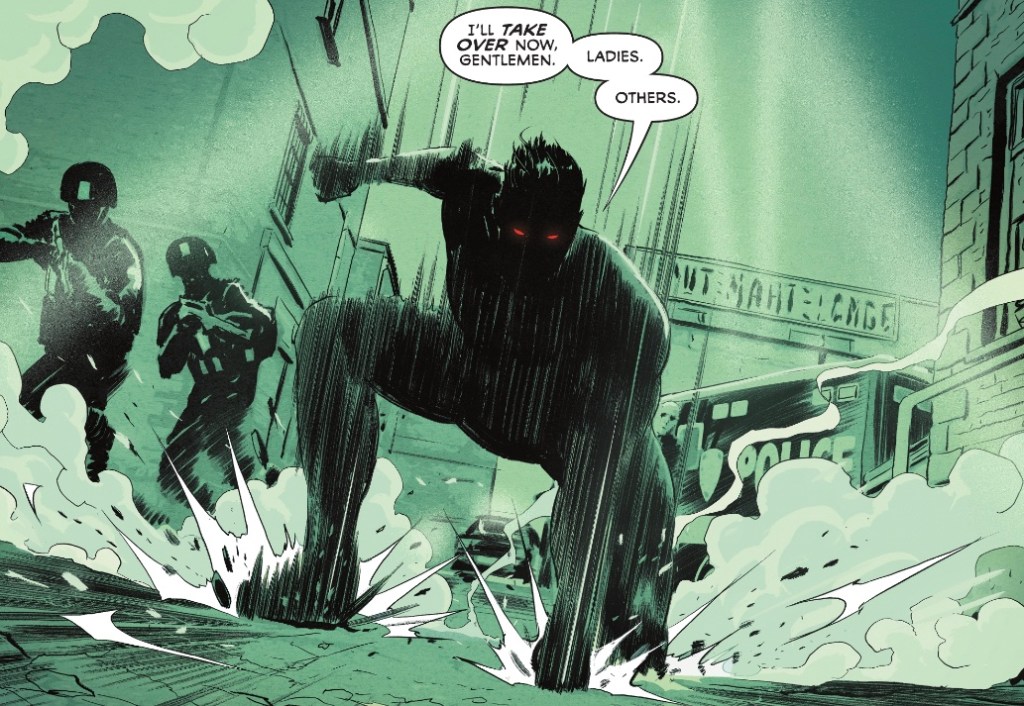
In 1963, President John F Kennedy has a request for Superman.

In the future, Superman has a request for Manchester Black.

One of the most memorable Superman stories of the last couple of decades was Action Comics #775’s ‘What’s So Funny About Truth, Justice and the American Way?’ With Wildstorm Comics’ The Authority showing how superheroes could beat the big problems of war, famine and so on if they put their minds – and abilities – to it, some readers were asking why DC characters didn’t do the same (over at Marvel, the Squadron Supreme had given it a go on their alternate Earth). Wishing to address the question, but unable to use the Authority, Action Comics writer Joe Kelly came up with analogous characters, The Elite, headed by Manchester Black, a mentalist in both senses of the word. Superman put him in his place, but decades on it seems that our hero – whose powers have weakened with age – has had a chance of heart.

In the years since that Action Comics issue, DC has bought the Authority, meaning Manchester Black can join an updated version of the team he and his mates riffed on. But writer Grant Morrison and artist Mikel Janín aren’t bringing back the whole team – only Apollo and Midnighter have been annnounced for this four-issue mini series. They’re going to be joined by female Steel Natasha Irons from Superman’s corner of the DCU; Enchantress of Suicide Squad fame; Lightray, the Flash of the Tangent Universe; and Omac, from bad crossovers. Together, they will change the world.
Maybe.
Cards on the table, given the number of telepaths around the DC Universe, I can’t for a second buy that Superman would bring in a sociopath who has tried to kill him and his family multiple times. Yes, Superman likes giving folk a shot at redemption, but even Black finds the idea nuts, quoting Amazing Grace.

But, Morrison is a terrific writer and has to have a plan… meanwhile, the fireworks between the serene Superman and the incredulous, impertinent Black are fun. The other characters don’t appear this time, but hopefully will be around by the start of next issue – I’d hate to see the entire mini devoted to the gathering of the team rather than the team getting on with stuff. Actually, a page of villains – we know they’re villains cos they’ve obviously not paid their electric bill – hints heavily that such won’t be the case.

So who do we have? Eclipso at far right. Perhaps Black’s old pal Coldcast at the back. The General? Ice gone bad? Dr Sivana after gender reassignment? A bulked-up Kryptonite Man?
This series was originally going to arise from DC’s proposed 5G timeline, which would have seen Superman, Wonder Woman, Batman and others appear in-world at the time of their real-world publishing debuts. Meaning the older Superman here – although apparently he’s still ageing more slowly than the rest of us – could conceivably have met Jack Kennedy.
Actually, he did, back on Earth One, in Action Comics #309, which was, unfortunately but unavoidably, published just after Kennedy was killed.

‘Who can I trust?’ As they said back in the Silver Age, ‘How ironic’?
With the Superman currently being published not having been around since 1938, there’s a quick fudge.

Lost in time? There’s a lot of it about right now… I don’t know why Morrison bothered with this – having worked hard to reestablish DC’s parallel worlds in their Multiversity series they should take advantage – present this as a story of a Superman on an Earth similar to the post-Crisis one.
Anyway, this comic is loads of fun. Details such as Superman’s exercise routine to stave off the effects of ageing, and changed public attitudes towards him, intrigue. Superman is charming with a bit of Golden Age edge, which is appropriate as he’s ready to go outside the law. Oh, and there’s a Phantom Zone breakout, giving Black the choice of helping Superman or, well, freezing to death in the Arctic wastes. Plus, there’s an appearance by one of my favourite Kryptonian beasties.
A scene showing Black being rounded on by the authorities is dragged out somewhat, but this is a 30pp story, and it motivates one of Janín’s most eye-popping pages.
Ah yes, the art. Janín never disappoints. His storytelling is exemplary, his individual compositions excellent and his action sequences thrilling. He knows how to give Superman a dramatic entrance.

OK, it’s very Marvel movie, but by cracky, it works – weaker or not, this is not a Man of Steel with whom you would mess. The one tweak I’d have asked for as editor would be to avoid a strong keyline on Black’s purple crop – the lack of same made him especially striking in his debut.
Janín’s Superman is beyond striking, ridiculously handsome and slick in his new outfit featuring Alex Ross’s Kingdom Come ‘S’ shield. And while Jordie Bellaire’s glowing tones are a boon throughout, the light-blue tone she gives Superman’s eyes really stand out. On the lettering side, Steve Wands beings his usual class to proceedings. And thanks, too, to editors Diego Lopez and Jamie S Rich for sharp steering.
Janín’s cover is classy, with Superman looking very much in control. I wonder how long that will last, given the characters he’s throwing in with. I’ll definitely be back next month to find out.
That’s obviously the Ultra-Humanite
LikeLiked by 1 person
Is that old gorilla not due a new body? I love UH!
LikeLike
I’d say the seated bulked up man is the General – it was Morrison who put Eiling in the Shaggy Man’s body in JLA so that makes sense to me. The one in the suit with the kryptonite? Ultra-Humanite’s a good guess but that jaw and the line about “my oldest enemy” makes me lean toward Luthor in his battle suit.
Oh, and when did the Flash of Earth-9 (the Tangent universe) become Lightray? Not heard that one before.
LikeLiked by 2 people
Luthor makes perfect sense! As for the Tangent Flash, I read it somewhere. It’s probably rubbish!
LikeLike
Grant Morrison can take a sub par idea; Superman leading The Authority; and craft a comic book showing why Superman would never do that.
5G is fast becoming like the DCs Cancelled Comics Calvacade of the 21st century: obviously it was a Dan DiDio Hail Mary to stay on as Co-Publisher but riddled with half-baked ideas, a fig leaf to conceal that DC was about to go down a very dark creative alley which would have taken years to claw itself out of. Thank goodness that 5G never saw the light of day 😀
LikeLiked by 1 person
I think I could take a few years of the originally 5G, rather than a few years of this! Or maybe they could have done it as a separate line.
LikeLike
I thought this was really good, but can’t figure out what “box” to put it in. Lord knows I’ve read a ton of books outside of continuity, especially the last few years, mostly Black Label. But — what is this?
Meant to be the current 5G status? But it was written, apparently, years ago. The solicit says this will “reverberate” through Action Comics and Son of Kal-El – meaning this is in some fashion in continuity?
The timing is all too convenient that Superman gets Manchester in position, and then post-surgery, with 12 minutes to spare – my suspicion is that Superman arranged the raid on Manchester Black, and then triggered the Phantom Zone release at the right time, as a ploy to recruit him
This is a Superman who appears to have gone over to the dark side, or a darker side. Perhaps I should think of this more like the bad Superman of Injustice.
I guess we’ll find out? Maybe. There’s a lot of insinuation – that the world rejected Superman, that he’s invaded privacy. Ultra-Humanite talks about Superman’s lies. I don’t know how all of this can be explored in this short mini-series.
So, is this just a “story,” an imaginary tale of an older Superman gone bad?
I guess we should wait and see. But I can see Morrison writing a story that has virtually nothing to do with DC’s crisis of the year. Why would he be restricted to playing in that sandbox?
It’s high quality, but I probably would have skipped it if I was sure it was unrelated to continuity, because my plate is kind of full at the moment. But that solicit — tricked me?
A reverberation can be metaphorical.
LikeLiked by 1 person
Pretty sure that you are right about this being a metaphorical reverberation. Seems clear to me at least that this is not current timeline/earth Superman…
LikeLiked by 1 person
I think they want us to see it as the future of the current continuity, maybe a few years after the Warworld business form the Future State Superman specials
This is definitely a darker Supes, but I think he’s some way off the Injustice fella… I do hope so, anyway.
Nice point about the reverberation!
LikeLike
Well damn. I was skeptical at first, but after giving this a read I think I’m in, at least for the next issue to see where it all goes next. Was not expecting that X-Men diss though. That’s usually something I expect to come out of Millar or Ennis’ mouth/mind, not Morrisons. Stll, very on brand for how Black talks & thinks. I’m definitely in it for the next one. It’ll be a redemption for him on me after not caring for his recent GL stuff. Glad I stumbled upon this review martin. Very glad indeed.
LikeLike
‘Stumbled’ up the review Dale? Are you not sitting desperately by the computer, waiting for the next one to drop! 🙂 As ever, it’s lovely to hear from you, and great to hear you liked this too. I didn’t take it that Grant was dissing the X-Men hugely, I took it more as an affectionate dig… and someone did point out he might have meant the Doom Patrol!
LikeLiked by 1 person
Yeah, true, it was probably that, and maybe loving jab at his old children too, just still seemed out of place for him of all people to say. Regardless, I’m intrigued enough to give the 2nd issue an honest chance.
LikeLiked by 1 person
Great review and great insight.
The lost in time line went right by me and possibly explains some of the nonsense. I don’t quite get why DC is clinging to 5G and Future State so tightly but here we are.
As for the villains, I glossed right by that page too. I hope it isn’t Luthor. I really hope it isn’t Batman. The General seems to make some sense. I would love for it to be Vyndktvx, a call back to Morrison’s Action run which riffed on the Golden Age Superman as well.
LikeLiked by 1 person
At some point, someone will call back to Morrison’s Action run… who’s to say it won’t be Morrison themself? I really must re-read them in a oner, I haven’t got your brain, you kept things straight much better than did I!
LikeLike
Late to this party, but nonetheless:
I refuse to believe this is in continuity (I tend to refuse to believe continuity is in continuity). I am reading this as: Superman and other heroes have failed to improve the world since 1963, and now Superman is turning to the current generation, and perhaps a slightly “outside-the-box” group because he needs that kind of approach. How many top-level telepaths are still in that alternate present, and how many would suit this mission, is an unknown that wouldn’t track with mainline status quo.
(If that was “our” Superman visiting 1963, he knows Kennedy will die in Dallas. So he says, “You need protection? No? Okay, good luck with that trip, then.” Which is unSuperman in the extreme. Either he’d accept that he can’t change history, and not bring up Dallas, or he’d do everything he could to prevent it. Just weird as presented, for a future, visiting Superman. Who also presumably wouldn’t reveal himself in the past for fear of messing up the future or whatever.)
All that aside, I was interested in the perspective Morrison is offering. As has been discussed widely, you have an older Superman speaking of his/his generation’s failures, and maybe that is a personal statement from Morrison. I was also struck by Black, who is a parody of entitlement whining here, and I wonder if that’s Morrison commenting on the current generation, either including Morrison’s own Invisibles-era youth, or as Morrison sees it contrasting with “these kids today.” This is the stuff that makes me most interested in the rest of the series.
Lastly, I liked the use of the Kingdom Come shield. I used to not like KC because it was a story fundamentally about Superman as a failure, and that’s not the (All-Star) Superman we know and love. The Superman I loved in my youth stood as an undefeatable force of justice. Always finding a way to win was the point. But now, the idea now of an older guy who has seen some failure, cannot be perfect, but still fights the good fight ever day, is a fairly useful and inspiring symbol as well.
Thanks as always for the sharp review; the attention to art as well as story, and the historical nuggets such as Superman’s original meeting with JFK.
LikeLike
No problem with being ‘late’, thanks for coming! And many thanks for the comments. The ‘Superman in 1963’ bit really is a stretch, I just can’t understand why Morrison didn’t go for an honest ‘out of continuity’ approach. It must be a DC directive. I never thought about the daft ness of Superman revealing himself in 1963, you’re so right. If he’s not changed his own future, he’s created an alternate timeline.
I never did read the Invisibles, I tried the first issue but it seemed too ‘cool kids’ for me. Maybe I should give it another go.
LikeLike
Mmmmaybe. I read it for the first time only in the past few years. It’s good, but no longer feels as transformative as its initial reputation. I just couldn’t shake the feeling that Manchester Black here is an older person’s perception of the original Invisibles audience/characters, outsiders eager to liberate themselves from their cultural oppressors/parents. And now, in the Fortress/healing scene, that Morrison avatar is just whining self-righteously and selfishly as the symbol of that older, mainstream culture just keeps trying to help him from a position of imperfection but sincere good will.
You read the Authority or the Invisibles and you’re supposed to sympathize with the antiheroes’ perspective. Here, it seems you could only see that outsider voice as a self-indulgent and ineffectual clown.
Anyway. Looking forward to #2 …
LikeLike